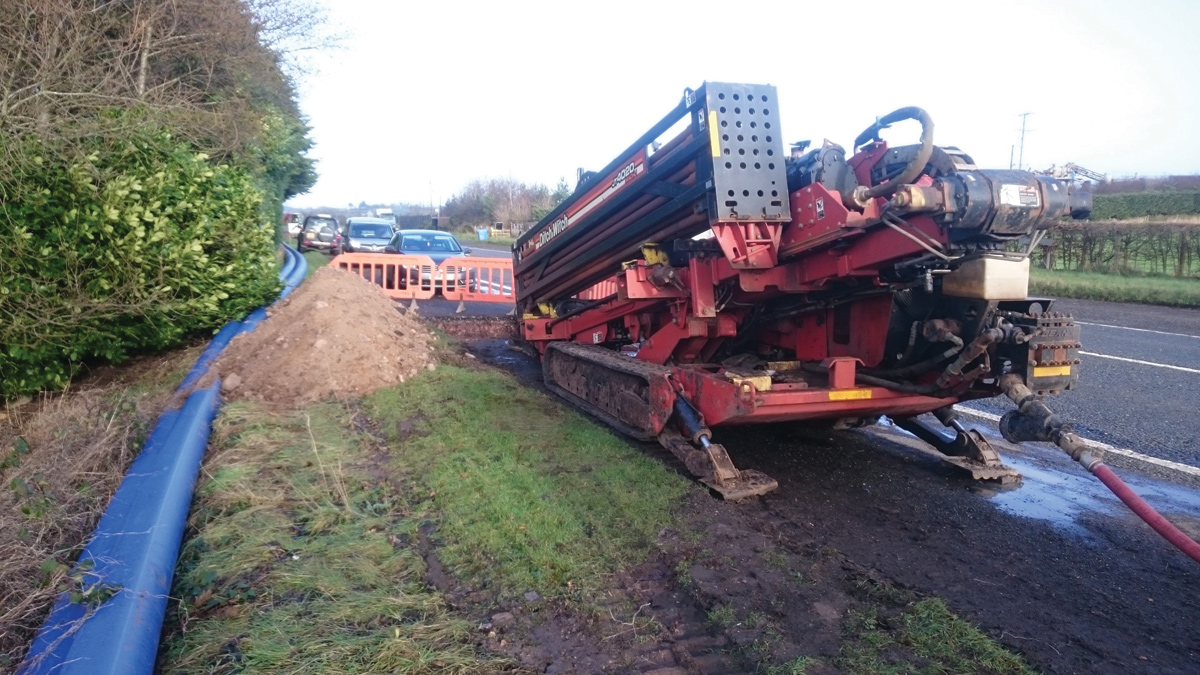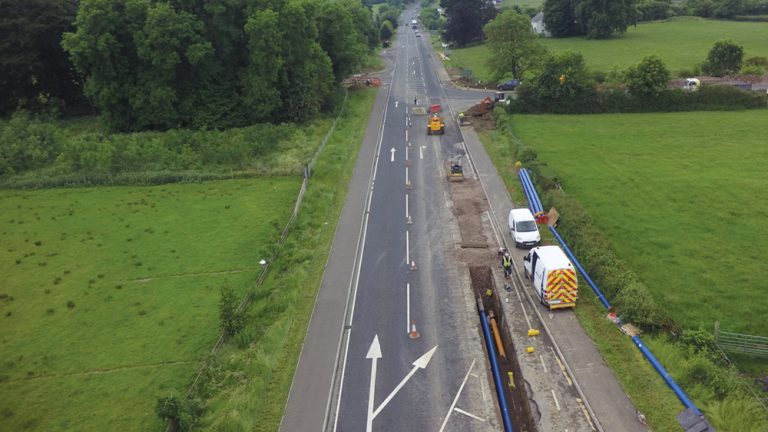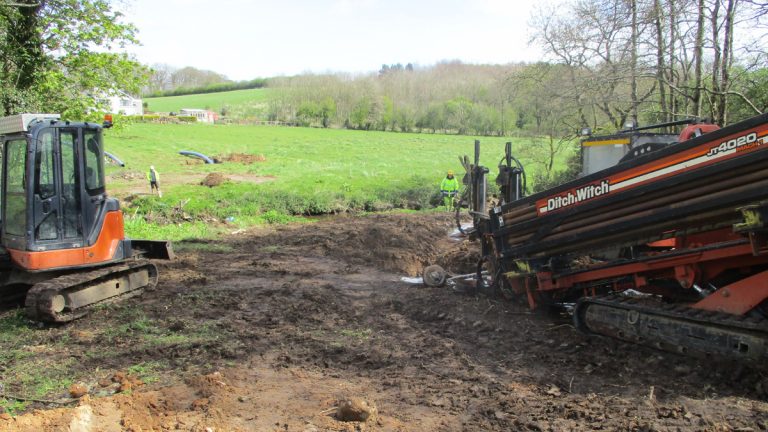Carland to Cookstown Strategic Link Main (2016)

Drilling machine - Courtesy of NI Water
Northern Ireland Water (NI Water) is committed to improving the water supply infrastructure across Northern Ireland to provide a robust and reliable network. Their Water Resource Management Plan (WRMP) 2012 details how the company proposes to manage its water resources into the long-term future. The WRMP looks 25 years ahead and states how the company aims to secure a sustainable supply of water taking into account expected demands and the implications of onerous demand conditions such as freeze/thaw and drought events. Baseline supply demand balance provides an indication of the level of surplus or deficit in each Water Resource Zone.
Project need
The Water Resource Management Plan 2012 highlighted a deficit of up to 4Ml/d in the Central Water Resource Zone under these onerous operating conditions and proposed options for resolving these operational shortfalls.The Carland to Cookstown Strategic Link Main project is the first phase of these works to address the Central Water Resource Zone deficit and will permit the transfer of up to 2Ml/d from the Southern Resource Zone which is supplied from Lough Neagh.
The project
The project was for the installation of 11,500m of 315mm (OD) PE100 SDR17 main from Carland Service Reservoir, just north of Dungannon, to the Morgans Hill District on the southern outskirts of Cookstown. The route required negotiating several rivers, road bridges and large road culverts. In addition ancillary works included:
- Connections to several District Metered Areas along the pipeline route adjacent to Cookstown to facilitate supplies to consumers in emergencies or during future maintenance.
- Flowmeter and telemetry installations at key locations to monitor flows and leakage.
The programme for the works commenced in November 2015 and at the time of writing (July 2016), the pipeline is scheduled to be fully operational by the end of August 2016.
Procurement route
The Carland to Cookstown Strategic Link Main Project contract was let through NI Water’s Integrated Framework IF019 – Capital Delivery Framework with 4 contractors issued with tender documentation.
The contract was awarded to Dawson-WAM Ltd in September 2015 under NEC ECC Option A; Priced Contract with Activity Schedule.
Project team
McAdam Design were appointed as NEC Project Managers for the construction phase and were also involved in the development of the scope and outline design, through to tender preparation, assessment and contract award.
Throughout the contract the wider project team (NI Water Engineering Procurement, the contractor, Dawson-WAM and project managers, McAdam Design) liaised closely with NI Water operational staff and their customer care/communications department to ensure minimal impact to the local community throughout the construction and commissioning phases.
Construction challenges
There were a number of significant construction challenges that the team had to overcome in order to complete the Carland to Cookstown Strategic Link Main Project:
The route
The pipeline route proposed was mainly along the A29 Dungannon to Cookstown Road which is a heavily trafficked primary route. This road is designated a ‘traffic sensitive’ road with working periods only permitted between 9.30am and 4.30pm.
Road closures are not permitted at any time due to the unsuitability of the surrounding road network to be used as diversionary routes by large or articulated vehicles.
In order for the works to be completed as efficiently as possible and to minimise traffic disruption, significant additional pre-construction survey works were undertaken by the contractor to establish the precise alignments and levels of existing services both in the hard shoulders/verges and carriageways along the length of the A29.

Pipelaying along the A29 – Courtesy of NI Water
This was accompanied by detailed boreholes and trial trenches to define the existing ground conditions including carriageway makeups.
These investigative works permitted routes to be chosen which minimised the installation of the pipeline within the main carriageway and also defined the sections where either open cut or horizontal directional drilling would be the preferred method of installation.
This then permitted the preparation of detailed traffic management plans to suit each installation method and site location. Generally the pipeline was able to be installed in hard shoulders and verges with only relatively short sections installed within the main carriageway itself.
Approximately 50% of the main was installed using horizontal directional drilling techniques with the remainder by traditional open cut methods. This significantly reduced the disruption to traffic movements on this busy highway as two lane traffic was able to be safely maintained for the majority of the works.
Ahead of pipelaying and throughout the civil works, NI Water customer care procedures ensured that key stakeholders (in particular local businesses and householders) were notified in advance of planned works and associated traffic management arrangements.
River crossing
The crossing of the Killymoon River Bridge also created a challenge both from an engineering and environmental aspect. The road bridge was constructed as a pre-stressed box section with the surface makeup of the highway laid to the soffit of the section. This meant that there would be no cover to the pipe, thus providing no structural protection or frost protection to the main.
Having reviewed a number of options it was agreed the bridge would be negotiated by diverting to adjacent fields and installing a twin main across the river by HDD methodology. The approach was discussed with all the relevant agencies (e.g. Rivers Agency, Inland Fisheries and NI Environment Agency’s Water Management Unit) and after submissions of proposals and method statements this was agreed.

Crossing of Killymoon River – Courtesy of NI Water
Connecting the strategic link main to the network
There were multiple connections to existing mains required and although in themselves these were not especially challenging from an engineering perspective, they required meticulous planning as many of the connections necessitated temporary shut downs, creating the potential to affect the supply to over 600 domestic and commercial properties.
Valving operation meetings were held with local NI Water staff to establish exactly how the section of mains would be isolated and which customers may be affected during the connection works.
Detailed method statements were then prepared by the contractor along with contingency plans to bring the network back into operation should any unforeseen issues arise during the proposed connection work. The majority of connections were undertaken between 9.00pm and 6.00am and advance notices were issued to the identified customers in case of any disruption to supply. The connections were completed with no supply issues notified to NI Water’s customer care line.
Coordination of works with other utilities
As part of the early consultations with various service providers at the pre-construction/planning stage it was discovered that gas company (Scotia Gas) was planning to undertake the laying of a natural gas pipeline sometime in the near future in the Cookstown area.
Discussions established that there would be areas where the route of both pipelines would be similar. After further liaison between both parties and Transport NI, a section of the proposed gas transmission main was laid alongside NI Water’s water pipeline at a particularly traffic sensitive section of the route, thus avoiding major disruption at this location again in the future.
Conclusion
The £2m Carland to Cookstown Strategic Link Main represents a vital part of NI Water’s wider long-term plan for rationalising and upgrading Northern Ireland’s water supply network.
Collaborative working, careful planning and a proactive approach to communications has helped NI Water’s Engineering Procurement team deliver this project on time, within budget, with an excellent health and safety record and furthermore with minimal impact on the local community.



